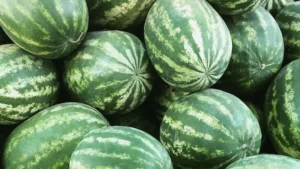Watermelon is a refreshing and delicious fruit that is perfect for summer days. However, there’s nothing worse than cutting into a watermelon only to find it is overripe or underripe. That’s why it’s essential to know how to pick the perfect ripe watermelon. In this article, we will share five easy tips to help you choose the perfect watermelon every time.
1. Look for a uniform shape and color
The first thing you should look for when selecting a watermelon is its shape and color. A ripe watermelon should have a uniform shape without any bumps or lumps. It should also have a consistent color, which is typically dark green with lighter green stripes.
Avoid watermelons that have irregular shapes or visible bruises, cuts, or soft spots. These can be a sign of improper growth or damage to the fruit during shipping or handling.
2.Check the field spot
The field spot is the area on the watermelon where it was resting on the ground while growing. This spot should be a creamy yellow color, indicating that the fruit is ripe. If the field spot is white or green, the watermelon is likely underripe.
When examining the field spot, make sure it is not too large or too small. A large field spot can indicate an overripe watermelon, while a small spot can indicate an underripe fruit.
3. Give it a tap
Tapping a watermelon can help you determine its ripeness. A ripe watermelon should sound hollow when tapped, indicating that it is full of juice. If the sound is dull or thud-like, the watermelon may be underripe or overripe.
When tapping a watermelon, use the pads of your fingers rather than your knuckles. The latter can cause bruising and damage to the fruit.
4. Check the weight
The weight of a watermelon can also indicate its ripeness. A ripe watermelon should feel heavy for its size, indicating that it is full of juice. If the watermelon feels too light, it may be underripe.
When checking the weight of a watermelon, compare it to other fruits of similar size. A watermelon that feels significantly lighter than others may not be ripe.
5. Look for a dull finish
A ripe watermelon should have a dull finish rather than a shiny one. This indicates that it is ready to eat and has reached its peak ripeness. If the watermelon has a shiny or glossy finish, it may not be ripe yet.
In addition to these five tips, it’s also essential to consider the season when selecting a watermelon. Watermelons are typically in season from June to August in the northern hemisphere. During this time, you are more likely to find ripe and delicious watermelons.
It’s also important to know that different varieties of watermelons may have different ripeness indicators. For example, some varieties may have a darker or lighter color when ripe, or a different field spot color. Be sure to research the specific type of watermelon you are purchasing to know what to look for.
Finally, it’s important to store your watermelon properly to ensure it stays ripe and delicious. Store your watermelon in a cool, dry place, such as a pantry or cellar. Once you cut into it, store any unused portions in an airtight container in the refrigerator.
In conclusion: selecting a ripe watermelon is easy when you know what to look for. Remember to check for a uniform shape and color, a creamy yellow field spot, a hollow sound when tapped, a heavy weight, and a dull finish. By following these simple tips, you can choose the perfect watermelon every time and enjoy this delicious fruit all summer long.


